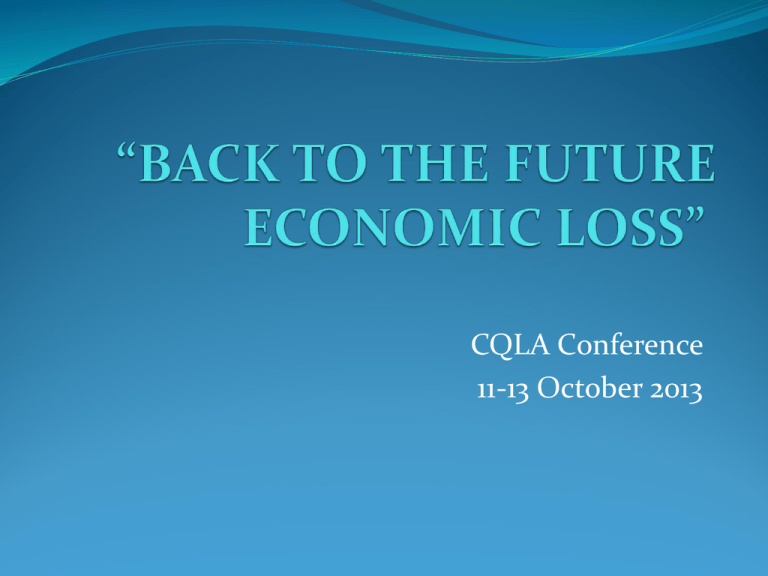“BACK TO THE FUTURE ECONOMIC LOSS”
advertisement

CQLA Conference 11-13 October 2013 1. LOSS OF ECONOMIC CAPACITY NOT FUTURE ECONOMIC LOSS 1.1 In Medlin v. State Government Insurance Commission McHugh J said:“In Australia, a plaintiff is compensated for loss of earning capacity, not loss of earnings. In practice, there is usually little difference in result irrespective of whether the damages are assessed by reference to loss of earning capacity or by reference to loss of earnings. That is because ‘an injured plaintiff recovers not merely because his earning capacity has been diminished but because the diminution of his earning capacity is or may be productive of financial loss’. Nevertheless, there is a difference between the two approaches, and the loss of earning capacity principle more accurately compensates a plaintiff for the effect of an accident on the plaintiff’s ability to earn income. Earning capacity is an intangible asset. Its value depends on what it is capable of producing. Earnings are evidence of the value of earning capacity but they are not synonymous with its value. When loss of earnings rather than loss of capacity to earn is the criterion, the natural tendency is to compare the plaintiffs pre-accident and post-accident earnings. This sometimes means that no attention is paid to that part of the plaintiff’s capacity to earn that was not exploited before the accident. Further, there is a tendency to assume that if pre-accident and post-accident incomes are comparable, no loss has occurred.” (1995) 182 CLR 1 @ 16 1.2 Professor Medlin ran out of “intellectual energy” and ceased working “retired” when aged 60 – question of philosophy – should the Defendant pay for loss of economic capacity beyond age 60. 1.3 Heywood v. Commercial Electrical Pty Ltd per Muir JA at para 53:“In any case, economic loss must be determined by reference to facts of that case. It is of no assistance, and it is highly likely to be productive of error, to attempt to set the level of an award for future economic loss by reference to awards in other cases by a process of adjusting, by means which are not apparent, to allow for differences in the extent of injury, ages and levels of income in the subject field of employment.” 1.4 In Heywood (supra) at para 57, Muir JA approved the assessment of damages for loss of future superannuation to be valued currently at 11.33%. The Appeal against the trial Judge’s award of $150,000 for future loss of earning capacity was dismissed. Thus, it cannot be said that a global award of damages for future loss of economic capacity is unavailable to a Court. [2013] QCA 270 1.5 In Heywood v. Commercial Electrical Pty Ltd the 28 year old plaintiff suffered from a severance of the ulna nerve in his left arm which left him with a 19% whole person impairment. He suffered daily pain, a significantly reduced grip strength, an inability to work with vibrating equipment and major problems with fatigue in his left arm. Although the plaintiff had been assessed as suffering from a 28% impairment of his left arm and as an electrician worked constantly with his arms and hands, the plaintiff’s claim for a loss of economic capacity equivalent to one-third of his pre-injury capacity, was rejected by the learned trial Judge at para 46. All that was said about the assessment of future economic loss is at para 48:“[5] [6] The plaintiff has established a diminution of earning capacity; he has not demonstrated with any degree of precision the loss that is a result of that diminution. Given his age- 28 – and the impairment which he has suffered, and after taking into account the usual contingencies and discounts an appropriate assessment for future loss of economic capacity is $150,000.” [2013] QSC 52 1.6 Although said to be a global sum, it is worth noting that Mr Haywood, at 29 years remaining the workforce, an award of $150,000 was the equivalent to an award of $185 per week. When injured, and even at trial, the Appellant was still an apprentice and the evidence placed before the Court showed that the average weekly nett earnings for an electrician in his age bracket was $1,085 nett per week in general electrical work and $1,891 per week in mining electrical work. Thus, the real award was a loss of approximately 17% of average weekly earnings of an electrician outside of the mining industry and just under 10% of the loss for mining electrician earnings. 2.0 LOSS OF ECONOMIC CAPACITY - A PERCENTAGE APPROACH 2.1 In RACQ Insurance Limited v. Brennan the Chief Justice said at para 22:“[22] … The Judge adopted a weekly loss ($500) which, taken with her residual earning capacity ($800), left her earning approximately 36% of the earnings achieved by her former subordinate co-employee Ms Nicols ($3,600). That appropriately respected the feature His Honour was evaluating the lost chance, and the uncertainties necessary attending that. [24] Mr Wilson criticised the reasons for failure to set out the assumptions and methodology (s55 Civil Liability Act 2003) behind the Judge’s selection of a loss of $500 per week. It is plain from his Reasons that he was comparing the respondent’s situation with that of Ms Nicols and Ms McLean, making adjustments to reflect the valuation of the chance. The Judge has done the best he could in an inherently uncertain area. To have pretended to greater precision would have been both inappropriate and artificial.” [2013] QCA 150 2.2 The s55(3) Civil Liability Act 2003 case – Allianz Australia Insurance Limited v. McCarthy and in particular White J at para 65 where Her Honour said:“The primary Judge’s Reasons do not reveal any basis at all for selecting $40,000 to compensate the respondent for loss of earning capacity and should be set aside as constituting an error of law.” 2.3 Whilst White J considered there should be no award for economic loss, Gotterson JA agreed with the President’s assessment of a small global sum of $15,000. The President said at para 10:“It is impossible to mathematically calculate the precise amount of this loss or even quantify it in terms of percentages of likelihood. But to do justice between the parties consistent with principles extracted from Malec, this is a case requiring a modest global award to reflect the contingencies I have discussed. Bearing in mind that Ms McCarthy has a long working life ahead of her and the relatively modest chance of significant economic loss I consider that she should receive $15,000 damages for future economic loss. In a case such as this, these Reasons sufficiently disclose the assumptions on which I base that award and the methodology used to arrive at it in terms of s55(3), see Ballesteros v. Chidlow and Another, and Reardon-Smith v. Allianz Australia Insurance Limited.” [2012] QCA 312 2.4 In Hunt v. Lemura Henry J said at paras 141 and 142:“[141] I would assume after Mrs Hunt was fit for work that a further period of 8 months would be required to allow for the above adverse contingencies in her successfully seeking employment. [142] It appears Mrs Hunt was fit or nearly fit for work by the time of her examinations on 29 April 2010 by Drs Weidmann and Toft. However, when Dr Burke examined Mrs Hunt on 27 August 2010 he recommended she undertake a 2 week intensive pain rehabilitation program. Adding some fair opportunity for her to properly prepare to return to work, it is reasonable to assume she would have been fit to return to work by 1 November 2010. [143] Allowing a further 8 months for her to successfully seek employment I assume she could have been back in comparable employment by 1 July 2011 at which time her past economic loss caused by the injury would have ceased.” [2011] QSC 378 2.4 In Hunt’s case Henry J referred to the s55(3) requirements before making a global award for future economic loss of $45,000 (for a 5% whiplash injury). The appeal was dismissed . 2.5 Weaver v. Endeavour Foundation; Phillips v. MCG Group; Hopkins v. WorkCover Queensland. [2012] QCA 183 [2013] QSC 93 [2013] QCA 83 [2004] QCA 155 3.0 SUMMARY 3.1 Subsection s55(3) of the Civil Liability Act and s306J of the Workers’ Compensation and Rehabilitation Act 2003 state:“If the Court awards damages, the Court must state the assumptions on which the award is based and the methodology it used to arrive at the award.” 3.2 The legislature has kindly suggested to the Courts that there is a preference to make awards for future economic loss “calculated by reference by a defined weekly loss”. 3.3 In order to calculate future economic loss by reference to a defined weekly loss, then one requires evidence of a difference between pre and post accident earnings to define that loss or, alternatively, evidence of a defined weekly loss by reference to the degree or percentage inability of the injured person to carry out their usual work tasks (which would preferably come from another and more experienced worker in the same industry) and, coupled with medical expert evidence and occupational therapist’s evidence in appropriate cases. 3.4 Courts, at the highest level, can, and still do, award global sums but the award is vulnerable unless the trial Judge complies with ss(3) of s55 or s306J, that is, by stating the assumptions and methodology. Again, whilst it is not necessary to define the loss by reference to an estimated weekly sum, it would seem to be safer. Thus again, evidence of the potential income that the plaintiff could have earned and evidence of the degree and extent of the plaintiff’s inability to perform the work is of particular importance. 3.5 Hopkins shows that there is no preference for a traditional approach of determining future economic loss by the difference between what one could have earned had they not been injured and what one has earned but, rather, the Court can simply choose a higher than usual discount, ie, 30% from the total loss. 3.6 Other methods are also valid such as Fail v. Suncorp where Moynihan SPJ found that the plaintiff was losing approximately $200 per week. His Honour said:“[23] The plaintiff’s submissions in respect of this head take as a starting point he suffers an approximate $200 per week when his earnings immediately prior to the accident are compared with his current earnings. The present value of $200 per week to aged 65 is $75,120. [24] As I have already indicated there are, however, a number of interactive variables to be taken into account which are a matter of judgment rather than calculation. … [26] Taking these considerations into account I will allow $200,000." Graeme Crow QC [2003] QSC 077 affirmed on appeal [2004] QCA 061 see in particulars paras 11 to 12 of the Judgment of McMurdo J








